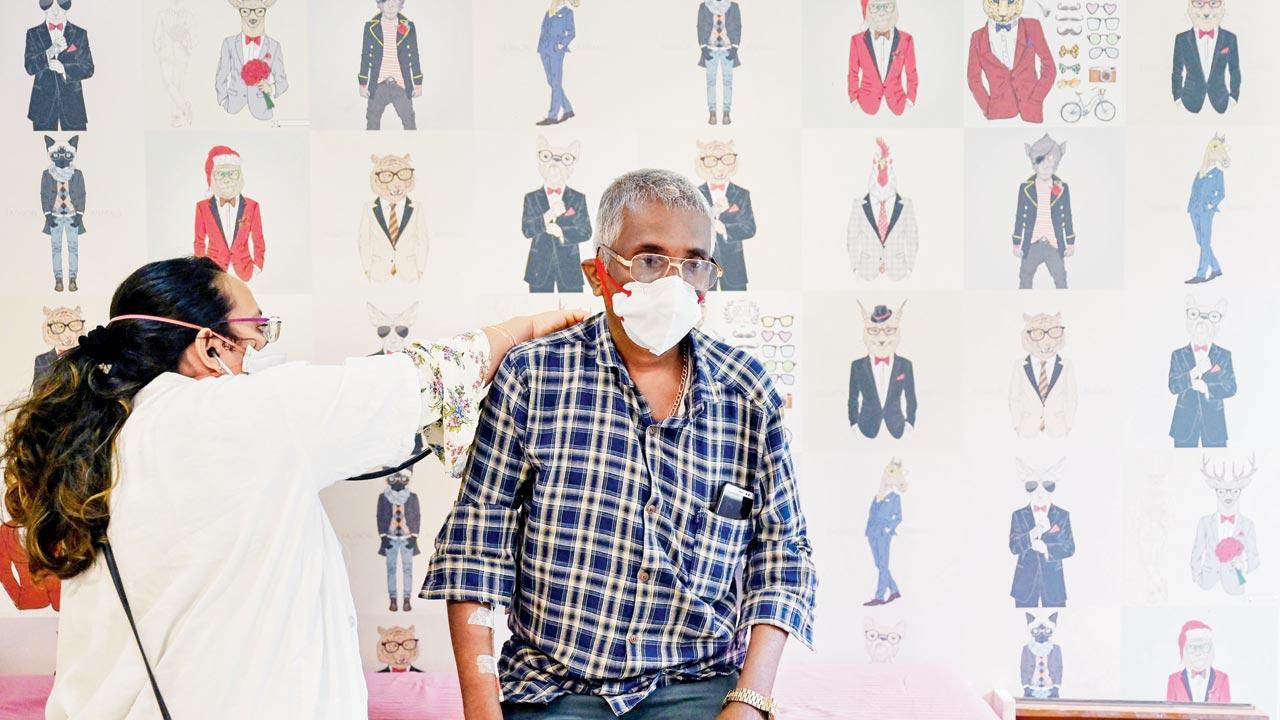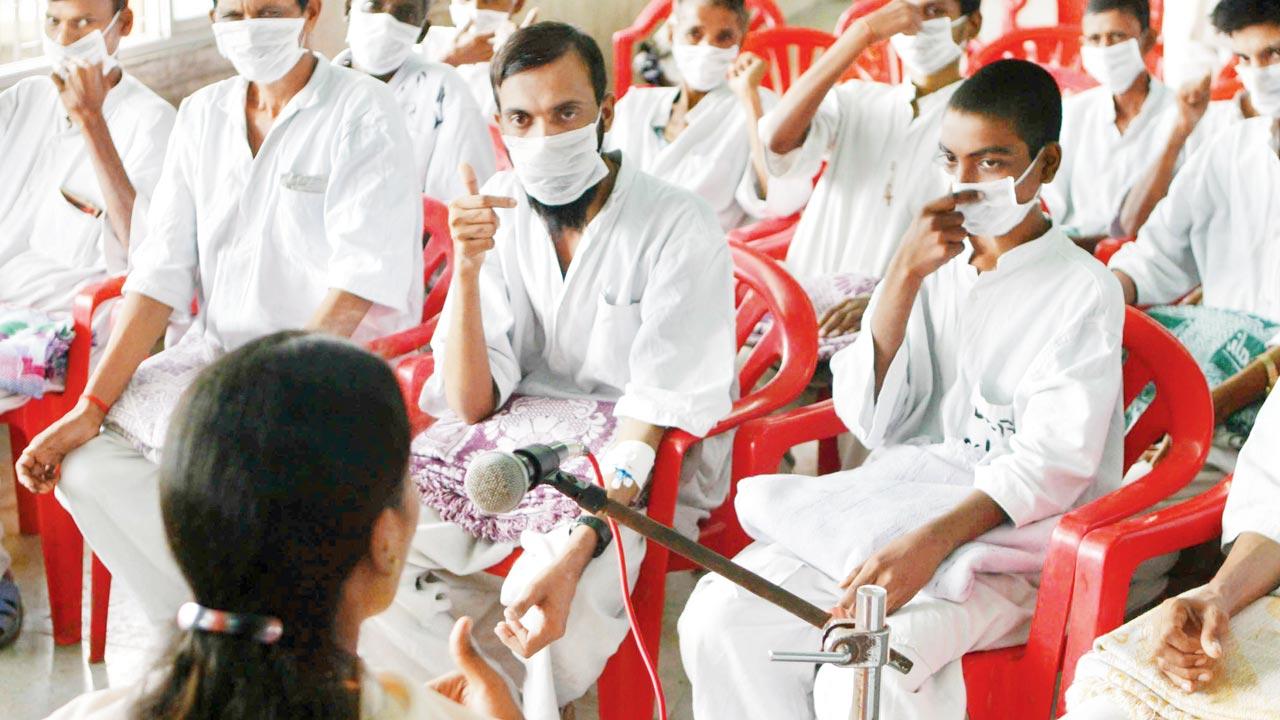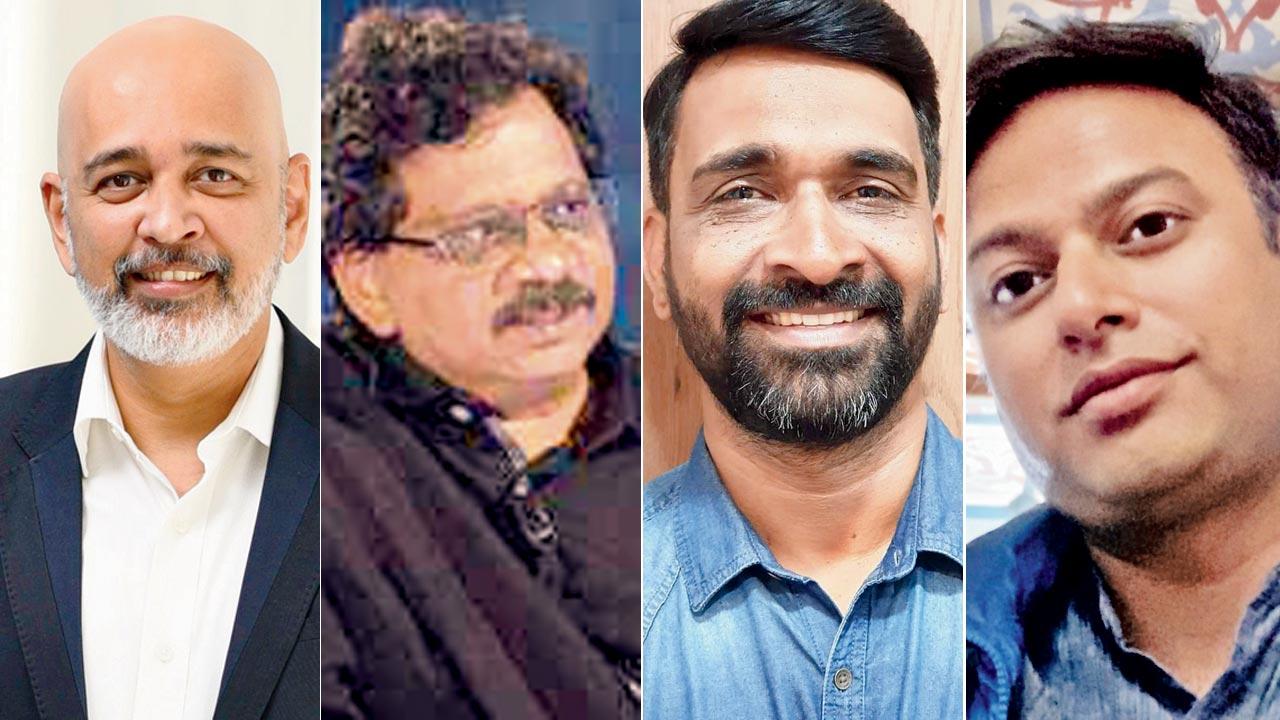India’s goal to become TB-free by 2025 has not just been impeded by the COVID outbreak, but also by poor policy implementation, rampant discrimination of patients and inability to measure up to newer drug-resistant strains

In this picture taken on March 22, 2022, a tuberculosis patient goes through a routine test at the Medicines Sans Frontiers (MSF) clinic, which treats people with drug-resistant tuberculosis, in Mumbai. When COVID-19 ripped through India in 2020-21, several million people died. Desperate efforts to stem the pandemic hurt the battle against another huge killer: tuberculosis. Pic/Punit Paranjpe/AFP Via Getty Images
Right at the beginning of his just released book, author-journalist Radheshyam Jadhav tells us the story of Owais, a resident of Dharavi, who suffers from drug-resistant tuberculosis. Owais, who is also HIV positive, relays his battle with the disease to activist Chapal Mehra. A migrant from Bihar, he made Mumbai his home many decades ago. He used to work as a tailor, but no longer has the energy to do anything. Speaking haltingly, he asks Mehra, “Why doesn’t anyone care?”
We should.
ADVERTISEMENT
TB kills 1,300 Indians every day. Yes, let that sink in.
 Tuberculosis patients undergo yoga therapy at Sewri Hospital. Pic/Getty Images
Tuberculosis patients undergo yoga therapy at Sewri Hospital. Pic/Getty Images
COVID-19 may have become an everyday virus, but TB, an infectious bacterial disease that mainly affects the lungs, still remains a giant killer. In fact, due to the COVID-19 lockdown, notifications of TB—process of reporting diagnosed TB cases to relevant health authorities—suffered a 60 per cent decline. As per the recently released India TB Report 2022, an estimated 1.9 million new active cases were notified in India in 2021. The total number of incident TB patients (new and relapse) notified during 2021 were 19,33,381—Mumbai accounted for nearly 60,000 of the total cases—as opposed to 16,28,161 in 2020. The mortality rate also grew between 2019 and 2020 by 11 per cent in India. At 31 per cent, India also has one of the highest childhood TB burdens in the world.
While the Centre may have set an ambitious goal of eliminating TB in India by 2025—five years ahead of the global target—the numbers are far from assuring.
Pune-based Jadhav feels that the government has effective policies and plans on paper, but is falling behind in execution. It’s what prompted him to investigate further and pen Lives on the Edge: Tuberculosis in Marginalised Populations (Speaking Tiger Books). “TB can affect anyone, but marginalised communities are affected the most—the stigma they face is different from what the urban population experiences. They are already discriminated against, and then TB comes as an additional burden. The problem is right from detection to treatment. They have to depend on government machinery. I wanted to understand what it means to be a TB patient in these communities,” he says.
 Sarthak Ranade, Lalit Anande, Radheshyam Jadhav and Chapal Mehra
Sarthak Ranade, Lalit Anande, Radheshyam Jadhav and Chapal Mehra
Instead of relying on data or expert voices for his research, he travelled the length and breadth of the country to find these stories. He shares how in Maharashtra’s Beed district, it’s the trans community that is massively affected. Much like in Sangli, Miraj, Satara and Kohlapur, which has a large community of Devadasis, who are also already infected with HIV. “This is a huge chunk of the population whose existence we don’t even acknowledge. They are not even aware of government policies and benefits.”
According to data by the National Strategic Plan for Tuberculosis Elimination (2017-25), India has more than a million “missing” TB cases every year. The results of a National TB Prevalence Survey released last year, showed that majority of the symptomatic population (64 per cent) did not seek healthcare services. Reason? Sixty eight per cent ignored their symptoms, 18 per cent did not recognise TB symptoms (see box), 12 per cent were on self-treatment, and two per cent could not afford to seek healthcare.
Jadhav also highlights the cases of women, already marginalised, dealing with TB. “A case study I use in the book is of Sunanda, who was married at the age of 14. She contracted HIV from her husband, and got TB soon after. It’s a hard life for her. I think we as a society have a role to play in this; we need to acknowledge, admit
and accept them as part of our world,” he says.
Speaking to mid-day, public health specialist Chapal Mehra says that even if we achieve TB-free status by 2040, it will be an achievement. “The rest is all sloganeering. We need diagnostic capacity, and the public sector has to strongly work with the private sector. TB drugs also need to be made more accessible. The government does a good job, but there are stockouts by private players. Many pharma companies want to stop making the drugs, as ingredients are expensive,” says Mehra, who is the founder of a community-based movement, Survivors Against TB.
“The worst part is that TB is causing deaths. Since it’s a curable disease, that’s unacceptable.”
According to Mehra, one of the biggest challenges at hand, is the stigma related to having TB. “Stigma mitigation has to be structured. Bolne se stigma khatam nahin hota.” Jadhav recalls a trans patient telling him that when he visited the hospital, a male nurse insulted him, saying, ‘You don’t even deserve to live’. Mehra adds, “We have also discovered that the disease and drugs cause mental health issues, including long-term term depression.”
At present, the Government of India’s National Tuberculosis Elimination Programme (NTEP) provides numerous health facilities with free treatment to all citizens. As per reports, Rs 1,488 crore was paid to 57.33 lakh TB patients under the Nikshay Poshan Yojana (NPY) as direct benefit transfer (DBT) from April 2018 to February 2022.
Private organisations are also being encouraged to join the Corporate TB Pledge, a joint initiative with the Central TB Division, Ministry of Health and Family Welfare in India, and United States Agency for International Development (USAID), to support the Indian Government’s goal to end TB.
Pharmaceutical industry company Johnson & Johnson, which is part of this pledge, believes that India is on track to achieve its goal. “For the TB mitigation strategy to be effective, it is important to increase awareness about the disease. The youth, who are widely adept at social media and other emerging technologies, can play a particular role in this effort by helping amplify the right messages about available care services, normalising conversations around TB and encouraging people to seek care,” says Sarthak Ranade, managing director, Janssen India & South Asia (The Pharmaceutical Companies of Johnson & Johnson).
Mehra says that right messaging will go a long way. He recently worked on the TB Pe Charcha campaign, an informative video series in Hindi and Marathi. “Patients asked us, ‘why haven’t we been told all this?’ They can’t read so there’s no use giving them pamphlets. We need to think out of the box.”
Dr Daksha Shah, Joint Executive Health Officer for the Municipal Corporation of Greater Mumbai (MCGM) and City TB Officer, says that the government is working on early detection so that the chain of transmission can be broken. “There are also newer treatments which will help. Just last week, the President of India, Droupadi Murmu, launched the Pradhan Mantri TB Mukt Bharat Abhiyaan, which is all about having a renewed focus on the TB issue. All government, NGO, and private partners are coming together, and have been put to work. If we can keep at it, the deadline of 2025 is possible.”
Dr Lalit Anande, former superintendent of the TB Hospital in Sewri, says that instead of relying on antibiotics, the government needs to focus on holistic treatment.
A 2017 report published in The Lancet Respiratory Medicine, warned that some of the progress made in the global fight against TB could be lost with the emergence and spread of drug-resistant strains of the disease. As per the report, approximately 20 per cent of TB cases globally are estimated to be resistant to at least one of the first- or second-line anti-TB drugs, and 5 per cent are resistant to both isoniazid and rifampicin, the most powerful and commonly used antibiotics in first-line treatment. Of the estimated 4.8 lakh cases of multidrug-resistant (MDR) TB, approximately 10 per cent are either extensively drug-resistant (XDR)—with additional resistance to second-line drugs—or totally drug resistant.
Anande says, “TB is a superbug, and doesn’t respond to antibiotics [anymore]. New medicines are being produced, but people will become resistant to them as well.” Anande says vitamins and antioxidants can accelerate TB recovery. “I have used appropriate doses of Vitamin D for my patients when I was at the Sewri TB Hopsital and they have been cured completely over time. In 1935, Mahatma Gandhi got TB. He used to drink goat’s milk, and that helped because it ensured that his levels of Vitamin D were always high.” Anande, like Mehra, believes that we need to push the envelope, if we aim to take care of this epidemic. If that includes looking into an enzyme called Gulo, which is active in most animals and produces Vitamin C, then we may have a fighting chance, he says. “It can become our best vaccine. We really need to change the way we fight this war.”
Symptoms to watch out for
. Coughing for three or more weeks (blood or mucus)
. Chest pain, or pain with breathing or coughing
. Weight loss
. Fever and chills
. Night sweats
. Fatigue
 Subscribe today by clicking the link and stay updated with the latest news!" Click here!
Subscribe today by clicking the link and stay updated with the latest news!" Click here!








